Rafflesia, the world's largest flower, is facing severe conservation challenges.
Habitat destruction and climate change are the main threats to its survival. This unique flower has a foul odor that attracts specific pollinators, making it vital for local ecosystems. However, around 60% of its species are critically endangered, and most of its habitats remain unprotected.
Rafflesia's parasitic nature, relying on jungle vines for nutrients, complicates propagation efforts.
Protecting its habitats and engaging local communities are essential conservation strategies. Understanding these complexities is crucial to developing effective conservation plans.
By addressing these challenges, we can work towards ensuring Rafflesia's survival amidst escalating threats.
Overview of Rafflesia
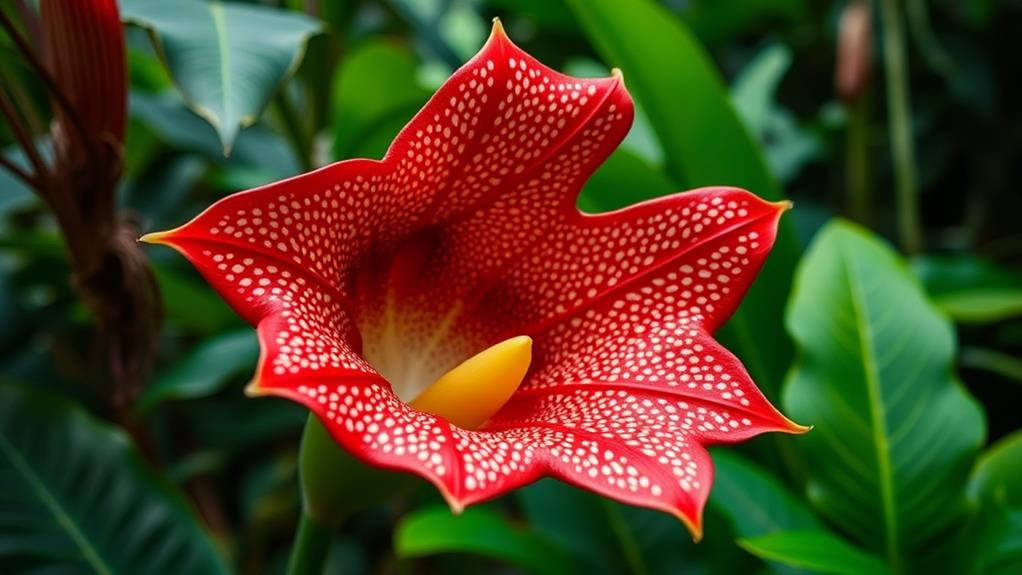
Rafflesia: A Unique and Threatened Genus
Rafflesia is a genus of parasitic plants that produces the world's largest flowers, with some species showcasing blooms that can exceed one meter in diameter. Found primarily in Southeast Asia, specifically in Brunei, Indonesia, Malaysia, the Philippines, and Thailand, this genus consists of 42 identified species, all of which are critically endangered due to habitat destruction and insufficient conservation efforts.
Unconventional Plant Structure
Rafflesia lacks traditional plant structures such as leaves, stems, and roots, relying entirely on jungle vines for nutrients. Its life cycle remains largely hidden until the flower finally blooms, revealing its striking appearance.
Ecological Role of Foul Odor
The foul odor of decaying meat emitted by Rafflesia serves a crucial ecological role by attracting flesh-eating flies, which are essential for the plant's pollination.
Threats to Survival
The ongoing threats of habitat destruction jeopardize Rafflesia's survival.
Targeted conservation efforts are urgently needed to protect these remarkable organisms and their unique ecological niches in Southeast Asia's biodiverse environments.
Conservation Status Overview
Rafflesia Species Face Alarming Conservation Status
The conservation status of Rafflesia species is critically endangered, with 60% classified as Critically Endangered. This alarming rate highlights the urgent need for better conservation efforts.
Habitat Destruction and Climate Change Pose Significant Threats
Rafflesia species are vulnerable to habitat destruction driven primarily by agricultural expansion. Approximately 67% of their habitats remain unprotected, making these remarkable flowers susceptible to destruction. Furthermore, many species face compounded risks from climate change, which poses a significant threat to their survival.
Limited Ex Situ Propagation Success Complicates Conservation
Limited success in ex situ propagation further complicates conservation initiatives. Many populations are restricted to a few individuals in unprotected areas, making it essential to develop comprehensive conservation strategies.
Comprehensive Conservation Strategies are Essential
Conservation efforts must include the addition of all Rafflesia species to the IUCN Red List and improved habitat protection measures. Urgent improvement in conservation strategies is necessary to ensure the survival of these species.
Conservation Status Overview
| Aspect | Status | Concerns |
|---|---|---|
| Classification | 60% Critically Endangered | Limited species on IUCN |
| Habitat Protection | 67% unprotected | Vulnerable to destruction |
| Ex Situ Propagation Success | Limited | Few individuals remaining |
| Climate Change Impact | Compounded risks | Threat to survival |
| Conservation Strategies | Urgent need for improvement | Essential for species survival |
Threats to Rafflesia Species
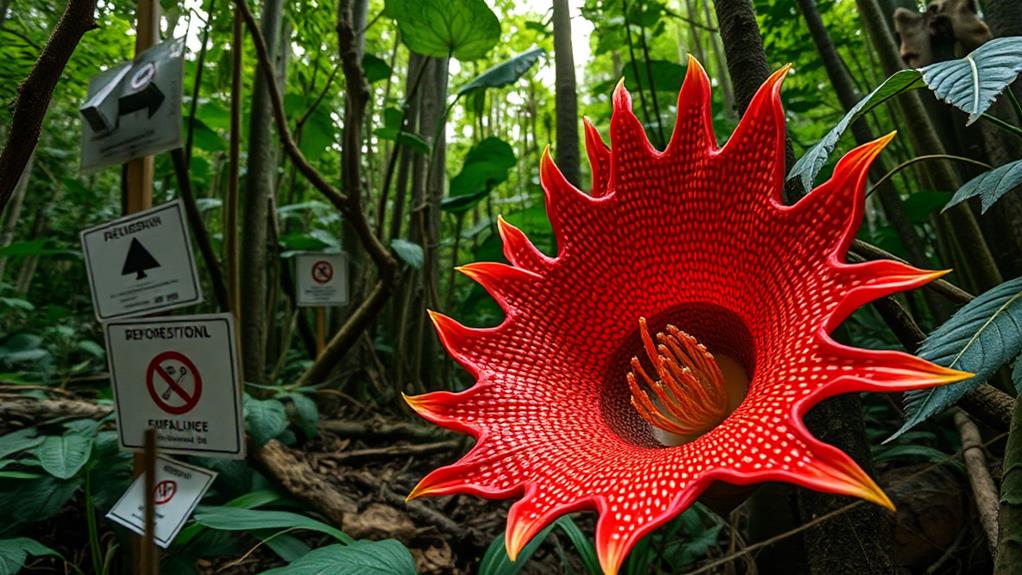
Threats to Rafflesia Species
Habitat Destruction and Fragmentation
Over 60% of Rafflesia species are critically endangered, primarily due to habitat destruction linked to agricultural expansion.
In Southeast Asia, approximately 67% of their habitats remain unprotected, making them highly vulnerable to environmental changes and deforestation.
For example, the destruction of forest habitats in Indonesia and Malaysia has led to the loss of Rafflesia habitats, further threatening their survival.
Urbanization and Deforestation
Rapid urbanization exacerbates the destruction of forest habitats, further diminishing the areas where Rafflesia can flourish.
As these habitats vanish, the delicate ecosystems that support Rafflesia's unique pollination processes are disrupted.
The destruction of habitats has led to the loss of Rafflesia populations, making it essential to protect their remaining habitats.
Climate Change
Climate change poses a serious threat to Rafflesia species by altering the environmental conditions necessary for their survival.
Changes in temperature and precipitation patterns disrupt the growth and development of Rafflesia, making it difficult for them to thrive.
Urgent Need for Conservation
With the potential for many Rafflesia species to become extinct before they're even scientifically documented, the urgency for conservation efforts can't be overstated.
Protecting their remaining habitats, addressing the impacts of climate change, and promoting awareness about these vulnerable species are critical steps in ensuring their survival.
Without immediate and effective conservation measures, the extinction of Rafflesia species could become an irreversible reality.
Unique Biological Traits
Rafflesia: The Largest Individual Flower
Rafflesia produces the world's largest individual flowers, with some blooms reaching over one meter in diameter and featuring distinctive speckled red petals. This unique feature allows Rafflesia to stand out among other flowers.
Parasitic Plant with No Leaves, Stems, or Roots
Rafflesia is a parasitic plant that lacks leaves, stems, and roots. Instead, it relies on tropical vines for nutrients.
It infiltrates its host's tissues through thread-like filaments, which is a unique biological trait that enables it to thrive in nutrient-poor environments.
Hidden Lifecycle and Elusive Characteristics
Rafflesia's lifecycle is largely hidden, with the flower emerging only after extensive internal development within its host.
This elusive characteristic highlights the need for further research, especially as new species continue to be discovered.
Reproductive Strategy and Ecological Importance
Rafflesia emits a foul odor resembling decaying meat to attract flesh-eating flies, which serve as its primary pollinators.
This unique reproductive strategy underscores its ecological importance and the need for conservation efforts.
Conservation Challenges and Delicate Ecosystem Balance
Rafflesia's adaptations not only facilitate its survival but also raise conservation challenges.
The delicate balance of its ecosystem must be maintained to ensure the survival of these remarkable plants in their native habitats.
Understanding Rafflesia's unique biological traits is essential for developing effective conservation strategies.
Habitat Protection Strategies
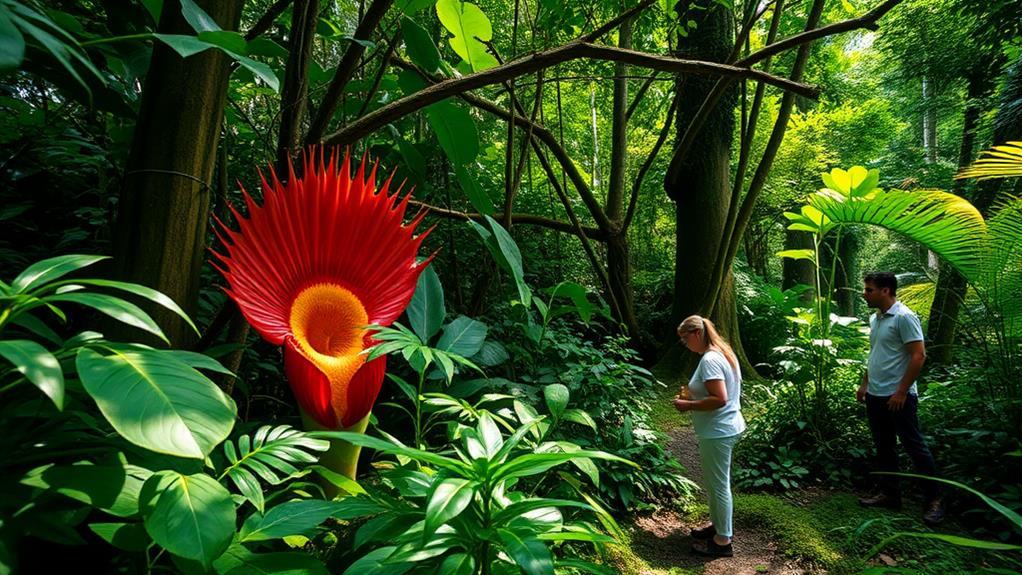
Protecting Rafflesia Habitats: A Critical Need
Only 33% of Rafflesia habitats are currently protected, leaving the remaining 67% vulnerable to threats such as agricultural expansion and deforestation. To address this, it is essential to include all Rafflesia species on the IUCN Red List, which will elevate their visibility and prioritize conservation efforts.
Strengthening Community Engagement
Indigenous peoples have proven to be effective guardians of the ecosystems where Rafflesia flourishes. By engaging with local communities, we can mobilize their efforts to conserve Rafflesia habitats. This collaboration can lead to more effective habitat restoration and protection.
Implementing Effective Strategies
Several strategies can be employed to protect Rafflesia habitats:
| Strategy | Description |
|---|---|
| IUCN Red List Inclusion | Enhances visibility and prioritizes conservation. |
| Community Engagement | Mobilizes indigenous peoples as conservationists. |
| Habitat Restoration | Focuses on rehabilitating degraded areas. |
| Cross-Regional Strategies | Coordinates efforts across different regions. |
| Collaborative Research | Involves scientists, communities, and policymakers. |
By implementing these strategies, we can ensure the long-term protection of Rafflesia habitats and the preservation of these unique flowers.
Role of Indigenous Communities
Indigenous communities are crucial for preserving the delicate ecosystems where Rafflesia thrives, significantly influencing biodiversity conservation efforts in Southeast Asia. Representing about 5% of the global population, these local communities actively engage in conservation efforts, particularly in Rafflesia habitats.
Traditional ecological knowledge from indigenous communities enhances our understanding of Rafflesia's natural habitats, informing effective conservation strategies.
In West Sumatra, tourism awareness groups (pokdarwis) emerge, promoting both Rafflesia ecotourism and conservation initiatives. Collaboration between scientists and indigenous communities is essential for successful monitoring of Rafflesia species and their ecosystems.
By integrating indigenous insights into scientific practices, conservation outcomes can be enhanced. Engaging local communities nurtures a sense of stewardship towards Rafflesia, ensuring sustainable practices that benefit both the environment and the people.
This collaboration not only fosters environmental protection but also provides economic incentives through sustainable ecotourism initiatives. When local communities recognize the value of Rafflesia, they become key players in its conservation, balancing ecological integrity with local livelihoods.
Ecotourism and Conservation

Local Involvement Enhances Ecotourism
The integration of traditional ecological knowledge from local communities significantly enhances the effectiveness of ecotourism initiatives focused on Rafflesia.
In West Sumatra, local villagers have formed tourism awareness groups that facilitate eco-friendly tours centered around blooming events. These initiatives engage the community and promote conservation efforts essential for habitat preservation.
Rafflesia's Conservation Icon Status
Rafflesia's unique status as the world's largest flower positions it as a conservation icon, attracting both tourists and researchers alike. The incredible size and beauty of the Rafflesia have made it a symbol of biodiversity and environmental protection. Tourists flock to see this amazing flower in its natural habitat, while researchers study it to better understand its ecology and conservation needs. Just as the banaue rice terraces are a testament to the ingenuity and skill of the Ifugao people, the Rafflesia serves as a reminder of the importance of preserving our natural world and the unique species that call it home.
Successful propagation efforts, such as those at the Bogor Botanic Garden, highlight the viability of Rafflesia in conservation narratives. Through targeted ecotourism programs, funding can be generated for conservation projects, providing financial incentives for local communities while safeguarding the species' natural habitat.
Collaboration with Indigenous Communities
Collaboration with indigenous communities is crucial for these initiatives.
Their traditional ecological knowledge contributes to effective conservation practices, ensuring that tourism benefits both the economy and the environment. By fostering a deeper understanding of Rafflesia's ecological importance, ecotourism can become a powerful tool for conservation, ultimately leading to sustainable practices that honor both the flower and the communities that protect it.
Current Research Efforts
Rafflesia Conservation Demands Immediate Attention
Recent research has identified 42 species of Rafflesia, highlighting the need for coordinated conservation efforts. Approximately 60% of these species are critically endangered, emphasizing the urgency for conservation actions.
Unraveling Rafflesia's Biology
Research is focused on understanding Rafflesia's complex lifecycle and its parasitic relationships with tropical vines, which are essential for its survival.
Studies have revealed the unique adaptations of Rafflesia, including the production of foul-smelling blooms to attract specific pollinators, a vital ecological interaction for maintaining biodiversity within its habitat.
Conservation Strategies
To bolster conservation efforts, researchers recommend increased sampling expeditions and comprehensive genetic analyses to better understand Rafflesia's ecological status and diversity.
Although initial breakthroughs in propagation techniques through tissue culture and in vitro seed germination have been limited, these efforts are crucial for ensuring the survival of Rafflesia species in their natural environments.
Integrating habitat conservation strategies with scientific research will be pivotal in reversing the alarming decline of these remarkable plants.
Propagation Challenges
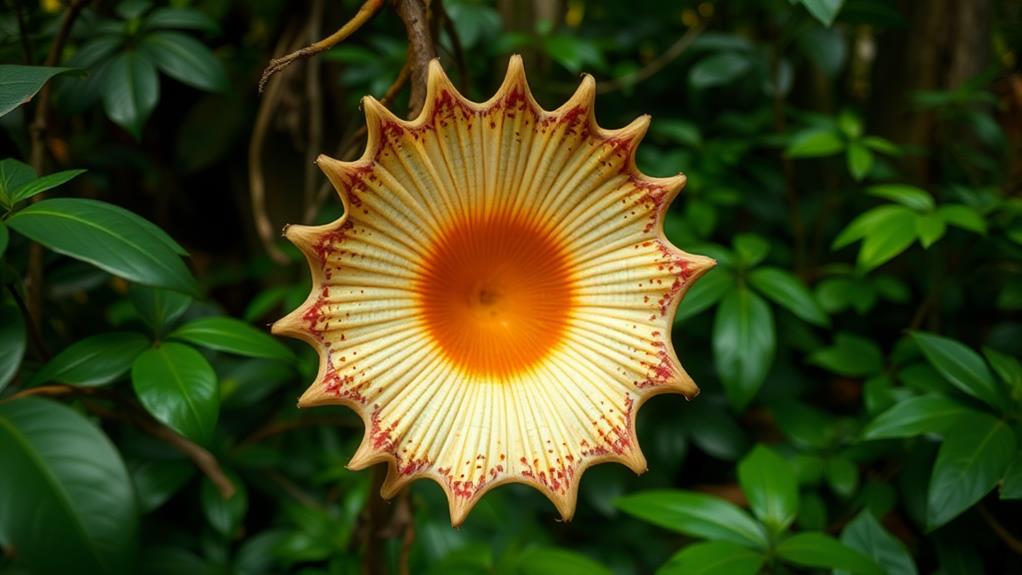
Rafflesia's Propagation Challenges
Conservation efforts for Rafflesia face significant obstacles due to its unique propagation challenges. The plant's parasitic nature hinders its cultivation, as it relies entirely on host tropical vines for nutrients. This complex relationship makes traditional seed banking and standard propagation methods ineffective.
Three key challenges impede Rafflesia's cultivation:
Parasitic Nature: Rafflesia depends on tropical vines for nutrients, making its cultivation particularly complex. For instance, botanic gardens like Bogor Botanic Garden in Indonesia have attempted to explore propagation techniques, but with limited success.
Unpredictable Blooming Cycle: Rafflesia flowers emerge sporadically, complicating cultivation efforts. This irregular blooming pattern makes it difficult to predict and prepare for seed collection and germination.
Ineffective Traditional Methods: Conventional seed banking fails to support Rafflesia's propagation. Innovative techniques, such as grafting and tissue culture, show limited promise. Research into tissue culture and in vitro seed germination has yielded few breakthroughs, highlighting the need for continued exploration of biotechnological methods.
Overcoming these hurdles is crucial for Rafflesia's conservation and future sustainability. By understanding and addressing these propagation challenges, conservation efforts can focus on developing effective strategies to preserve this unique species.
Pharmacological Potential
Rafflesia's Pharmacological Potential
Rafflesia's unique characteristics make it an attractive subject for pharmacological research. Local communities have traditionally used Rafflesia species in ethnobotanical medicine, suggesting promising pharmacological applications.
Recent studies have shown that extracts from Rafflesia exhibit significant antimicrobial properties, making them viable candidates for developing natural medicines.
The unique chemical compounds present in Rafflesia could lead to novel therapeutic agents. For example, researchers have identified compounds with antibacterial and antifungal properties, which could be used to develop new treatments for infections.
This rich area of research has the potential to uncover new compounds with substantial medicinal value.
Despite its potential, the elusive nature and complex life cycle of Rafflesia have limited scientific exploration of its pharmacological potential. This gap in research highlights the need for increased investigation into the bioactive compounds found within Rafflesia.
As conservation efforts gain momentum, they may pave the way for discovering new compounds with substantial medicinal value.
Community Engagement Initiatives
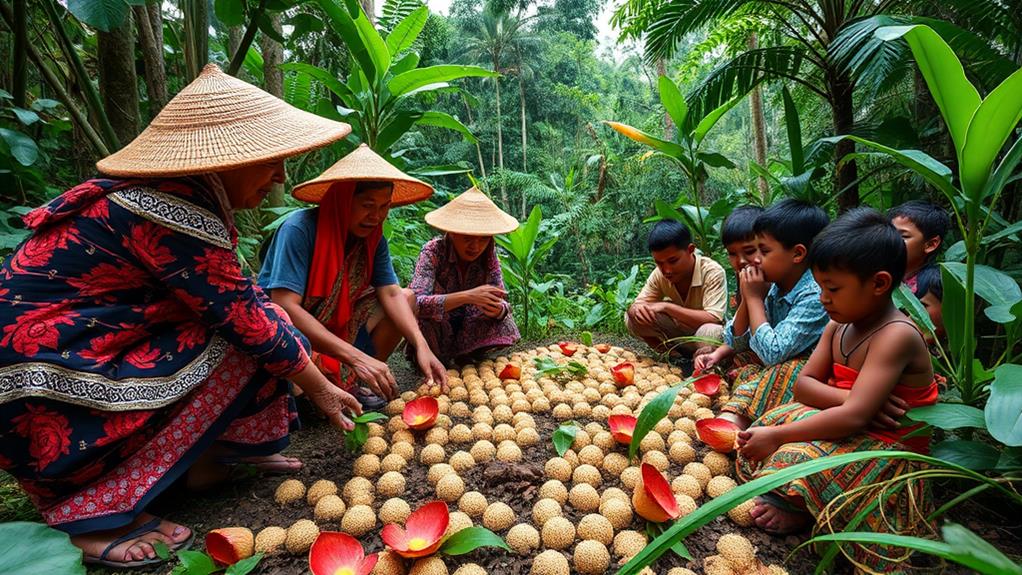
Community Engagement Initiatives
Involving local communities in Rafflesia conservation is crucial for its survival. Effective community engagement initiatives are essential for securing the future of Rafflesia species.
Ecotourism Programs
Local ecotourism programs economically empower villagers while promoting Rafflesia awareness. For instance, in the Philippines, community-based tourism associations provide income opportunities for local villagers, encouraging them to protect Rafflesia habitats.
Knowledge-Sharing Activities
Knowledge-sharing activities educate communities about conservation efforts and the ecological significance of Rafflesia. Local conservation groups, such as government units, organize workshops and training sessions to raise awareness about Rafflesia's importance.
Social Media Campaigns
Social media campaigns generate public interest and attract tourists to blooming events, enhancing conservation visibility. Online campaigns, like #RafflesiaConservation, create awareness about Rafflesia's conservation status and promote responsible tourism practices.
Collaborative Networks
Collaborative networks between scientists and local communities facilitate monitoring Rafflesia habitats and sharing best practices. Local communities, in partnership with scientists, monitor Rafflesia populations, identifying areas that require conservation efforts.
Future Conservation Directions
Immediate Conservation Actions
To ensure the survival of Rafflesia species, adding all Rafflesia species to the IUCN Red List is crucial. This listing emphasizes their critically endangered status and drives conservation efforts.
Currently, around 67% of Rafflesia habitats remain unprotected and face threats from agricultural expansion, making habitat protection a top priority.
Community Engagement and Research
Collaborative conservation strategies that engage local communities and indigenous peoples are vital for preserving Rafflesia and its habitats. By fostering community engagement, a sense of ownership and responsibility towards these unique plants can be created.
Additionally, further research into Rafflesia's biology and ecology is necessary to provide insights into effective propagation techniques and its ecological significance within ecosystems.
Ecotourism and Funding
Ecotourism initiatives can play a transformative role in funding conservation efforts while raising awareness of Rafflesia's biodiversity.
Questions and Answers
What Is the Issue With Rafflesia?
Rafflesia's Habitat and Lifecycle Are Under Threat
Rafflesia's existence is precarious due to the destruction of its unique habitat and the complexity of its lifecycle. Habitat destruction and deforestation hinder the plant's ability to thrive, as it relies on specific environments to grow. For instance, Rafflesia needs undisturbed rainforests with rich soil and a particular type of vine, Tetrastigma, to host its roots.
Pollination and Distribution Challenges
Rafflesia's unique adaptations for pollination and distribution are also compromised. The plant's strong odor and appearance, which mimic rotting flesh, attract carrion-feeding flies that aid in pollination. However, these distinct features are often overshadowed by the urgent need for research and cultivation efforts to ensure the plant's survival.
Mythology Complicates Ecological Understanding
The rich mythology surrounding Rafflesia often distracts from its ecological significance. Many species of Rafflesia may vanish before we can fully document their importance in biodiversity, highlighting the need for focused research and conservation efforts.
What Are the Threats to Rafflesia?
Rafflesia faces numerous threats to its survival. One of the primary threats is habitat destruction, which is caused by deforestation and agricultural expansion. As forests are cleared for agriculture, Rafflesia's habitat is destroyed, leaving it without a place to grow.
Climate change exacerbates these issues by impacting pollination and genetic diversity, which are crucial for Rafflesia's survival. Rising temperatures and changing weather patterns disrupt the delicate balance of Rafflesia's ecosystem, making it harder for the plant to reproduce.
Invasive species and tourism also strain Rafflesia's fragile ecosystems. Invasive species can outcompete Rafflesia for resources, while tourism can lead to habitat degradation and disturbance.
Increased conservation awareness and research initiatives are necessary to address these challenges.
Implementing sustainable practices is vital to protect Rafflesia and ensure its continued existence amid these escalating threats.
Why Is Rafflesia Endangered?
Rafflesia is endangered primarily due to habitat destruction, which disrupts its unique life cycle and symbiotic relationships with host plants. This destruction occurs when forests are cleared for agriculture, urbanization, and logging, leaving Rafflesia without a place to grow.
Rafflesia's survival also relies on specific insects for pollination, making its pollination methods highly specialized. For instance, the Rafflesia pricei, a species of Rafflesia, relies on carrion-feeding flies to transfer its pollen.
Climate change further threatens Rafflesia's survival by altering the suitable climate conditions required for its growth. Rising temperatures and changing rainfall patterns can make it difficult for Rafflesia to thrive.
Without focused research initiatives, understanding Rafflesia's reproduction methods and cultural significance becomes challenging.
This lack of understanding risks the extinction of Rafflesia species before adequate documentation occurs. It's essential to prioritize research to conserve Rafflesia effectively.
What Is Being Done to Protect the Rafflesia Flower?
Conservation efforts are underway to protect the Rafflesia flower. These efforts include research funding directed towards genetic studies to enhance understanding of its biology. For instance, scientists are studying the flower's unique characteristics, such as its lack of chlorophyll, to develop effective conservation strategies.
Community involvement is crucial in Rafflesia conservation. Ecotourism initiatives promote local economic benefits while raising global awareness about the flower's importance. In particular, local communities are involved in guiding tourists to Rafflesia habitats, generating income and promoting sustainable practices.
Restoration projects aim to revive Rafflesia habitats. These projects focus on replanting native vegetation and removing invasive species that threaten the flower's ecosystem. Additionally, protected areas are being established to safeguard these ecosystems from human activities that may harm the Rafflesia.
Environmental education programs empower communities to support Rafflesia conservation. These programs teach sustainable practices, such as responsible land use and waste management, ensuring that local communities can coexist with the Rafflesia. By doing so, communities can ensure the long-term survival of the flower.